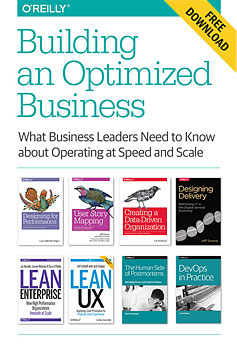"lean enterprise" entries

Deploy Continuous Improvement
Balancing the work it takes to improve capability against delivery work that provides value to customers.

Download
Building an Optimized Business
Download a free copy of Building an Optimized Business, a curated collection of chapters from the O’Reilly Web Operations and Performance library. This post is an excerpt by Jez Humble, Joanne Molesky, and Barry O’Reilly from Lean Enterprise, one of the selections included in the curated collection.
In most enterprises, there is a distinction between the people who build and run software systems (often referred to as “IT”) and those who decide what the software should do and make the investment decisions (often called “the business”). These names are relics of a bygone age in which IT was considered a cost necessary to improve efficiencies of the business, not a creator of value for external customers by building products and services. These names and the functional separation have stuck in many organizations (as has the relationship between them, and the mindset that often goes with the relationship). Ultimately, we aim to remove this distinction. In high-performance organizations today, people who design, build, and run software-based products are an integral part of business; they are given — and accept — responsibility for customer outcomes. But getting to this state is hard, and it’s all too easy to slip back into the old ways of doing things.

What should replace the project paradigm?
Creating alignment at scale within enterprises.

The problems caused by using the project paradigm to delivering software systems are severe. The effect of projects on downstream teams such as release and operations were, for my money, most succinctly articulated in Evan Bottcher’s article “PROJECTS ARE EVIL AND MUST BE DESTROYED“. The end result — complex, heterogeneous production environments that are hard to change or even keep running — is due to the forces Charles Betz identifies in Architecture and Patterns for IT Service Management, Resource Planning, and Governance: Making Shoes for the Cobbler’s Children:
Because it is the best-understood area of IT activity, the project phase is often optimized at the expense of the other process areas, and therefore at the expense of the entire value chain. The challenge of IT project management is that broader value-chain objectives are often deemed “not in scope” for a particular project, and projects are not held accountable for their contributions to overall system entropy.
Furthermore, bundling work up into projects combines low-value features with high-value features in order to deliver the maximum viable product that is the inevitable result of the large-batch death spiral. This occurs when product owners try and stuff as many features as possible into the next release so they don’t have to wait for the one after in order to get them delivered. As a result, the median cycle time for delivering features is often poorly correlated with their priority — a highly undesirable outcome.
Why do we stick with it? Because our budgeting processes are designed to operate on projects, and project managers and the PMO know how to deliver them.
Since these are clearly poor reasons, what should we do instead?

4 significant ways to improve your ability to innovate
Liberate teams from the annual budget cycle.

The use of the traditional annual fiscal cycle to determine resource allocation encourages a culture that thwarts our ability to experiment and innovate. It perpetuates spending on wasteful activities and ideas that are unlikely to deliver value. How can we get out of the rut that is the annual budget process and encourage experimentation and innovation within our organization?
When it comes to budgets, It is hard to let go of the long-held belief that strong, centralized control provides valuable efficiencies. However well it may have served us in an era of lower complexity and slower technical advances, it now creates barriers that prevent us from adapting quickly to emerging opportunities. In this context, the resources and efforts required to gather information, communicate, and monitor rigid centralized processes outweigh any efficiencies gained. As well, a strongly controlled centralized budget process encourages competitive, rather than collaborative, internal behavior. This is counter-productive to innovation, which requires teamwork and collaboration across the organization.